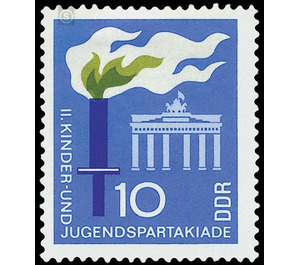Children and Youth Spartakiade, Berlin - Germany / German Democratic Republic 1968 - 10 Pfennig
Theme: Architecture
| Country | Germany / German Democratic Republic |
| Issue Date | 1968 |
| Face Value | 10.00 |
| Color | blue |
| Perforation | K 13 1/2: 13 |
| Printing Type | offset |
| Stamp Type | Postage stamp |
| Item Type | Stamp |
| Chronological Issue Number | 1117 |
| Chronological Chapter | GER-DDR |
| SID | 398811 |
| In 17 Wishlists | |
II. Children and Youth Spartakiade The Ministry of Posts and Telecommunications of the German Democratic Republic issues two special stamps for the Second Child and Youth Spartakiade. II. Children's and Youth Spartakiads From July 23 to 28, 1968, the II. Children's and Youth Spartakiads of the GDR will take place in the Olympic summer sports disciplines in Berlin, the capital of the German Democratic Republic. In 23 sports, around 13,000 children and adolescents aged 10 to 18 will compete in sports competitions and find out about 1,500 Spartakiad winners. From 22 to 26 February 1968, the Spartakiade had already taken place in the winter Olympic sports in Oberhof, Goldlauter and Berlin. 1,500 children and young people from all districts of our German Democratic Republic fought here on hills, trails, slopes and the Berlin ice skating areas for the coveted Spartakiademedaillen. Spartakiad - like a magnet, this word has attracted millions of enthusiastic children and adolescents every year since 1965. Starting in the schools and sports communities, every girl and every boy has the opportunity to progress through district and district divisions to the central Spartakiad and fight for victory every two years with the best from all districts of the GDR. Thus, the Spartakiadebewegung to a unique talent show. It is no exaggeration to say that today's Spartakiad winners will be tomorrow's Olympic champions. Examples should make that clear. At the first Kinder- und Jugendspartakiade in summer sports in 1966, which also took place in Berlin and attended by 13,000 boys and girls, the 800-year-old Barbara Wieck from Rostock started over 800 m. She ran this distance in 2: 10.3 minutes. With this time, one could have won a gold medal at the 1928 Olympic Games in Amsterdam. In junior decathlon Max Klauß became Spartakiadesieger. A few months later, he finished fourth at the European Athletics Championships in Budapest in the decathlon. 15-year-old Rita Schmidt from Leipzig won the competition in the high jump. A year later she was already on everyone's lips when she was with the III. European Indoor Athletics won the high jump and a few months later in the hall jumped the height of 1.85 m. The winner in the back end disciplines was the Erfurt Roland Matthes. In 1967 he caught the attention of the experts when he set world records over 100 and 200 meters back and won the same disciplines at the international sports games in Mexico City. The same can be reported by the winter sports. The participants in the 1968 Winter Olympics in Grenoble, Ruth Schleiermann and Jan Hofmann, were both winners and placed at the Spartakiads 1966 and 1968 in the Olympic winter sports. There is another side of the Spartakiad movement that is also very significant. The Spartakiadebewegung serves in addition to the talent show above all the extraction of all children and young people for a regular participation in a multiple weekly sports training and thus the all-round physical and mental education and education of the younger generation. In 1965 and 1966, around 2.5 million boys and girls between the ages of 10 and 18 took part in competitions, excretions and Spartakiads in the districts and districts in preparation for the First Child and Youth Spartakiade. This number makes u.a. Also clearly the close relationship between the Spartakiadebewegung and the new socialist constitution of the GDR, which says in Article 18: "Physical culture, sport and tourism as an element of socialist culture serve the all-round physical and mental development of citizens".


